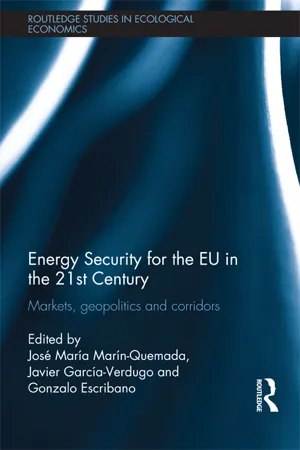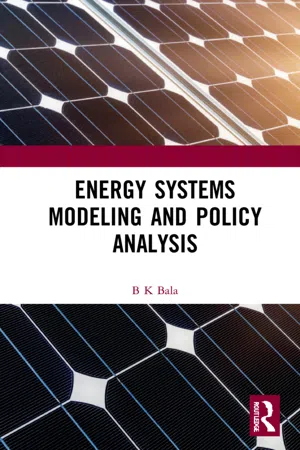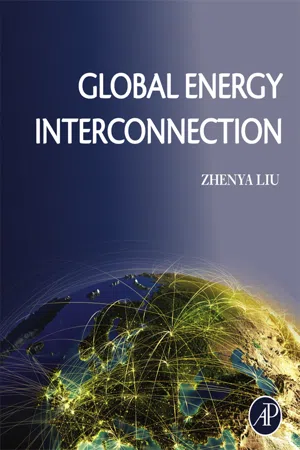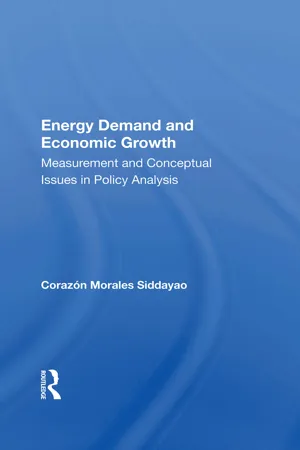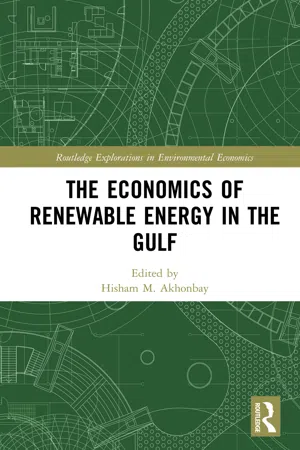Geography
Energy Supply and Demand
Energy supply and demand refers to the balance between the amount of energy available and the amount needed. It encompasses the production, distribution, and consumption of energy resources such as fossil fuels, renewable energy, and electricity. Understanding energy supply and demand is crucial for addressing energy security, sustainability, and environmental impacts.
Written by Perlego with AI-assistance
Related key terms
7 Key excerpts on "Energy Supply and Demand"
- eBook - ePub
Geopolitics of Energy in Central Asia
India's Position and Policy
- Ramakrushna Pradhan(Author)
- 2020(Publication Date)
- Routledge India(Publisher)
In a world of rapid progress and fast-paced industrialization, energy occupies the top priority. Therefore, to ensure timely, adequate, reliable and cheap energy, its secure and easy availability is of the utmost importance. Only this can enable the country to sustain its economic growth, maintain its society’s lifestyle and feed its military needs. For that, competition plays a major role, because most of the world’s principal energy producers are not principal consumers. For them, the concept of the geopolitics of energy arises, revolving around who supplies it, as securing reliable access to those supplies has been a driving factor in global prosperity and security. The structural dimensions of energy geopolitics can be seen from both the supply and demand sides. The supply side includes the volumes of global reserves, their distribution patterns, their longevity, the discoveries, capacity building and so on. On the demand front, the issues are related to the market size and its geography, logistics of transport and its delivery and others.The geopolitics of energy in today’s world principally revolves around oil and gas and to a lesser degree around nuclear and hydroelectricity sources, of which oil and gas are essentially geopolitical commodities. Since the availability of hydrocarbons is determined by geology, the global politics of energy is shaped mainly by the “arc of energy”, stretching from the Gulf region to the Caspian Sea, through Siberia and the Arctic region to the Russian Far East, Alaska and Canada. In this regard, it can be said that nearly 80 per cent of the world’s oil and gas including potential reserves are located in this region (Sikri 2008: 2).Nevertheless, factors like economics, technology and politics played critical roles in determining the supply and demand side of the energy geopolitics. For the energy-producing countries, energy is not only a source of enormous power and wealth, it also constitutes leverage. Since energy is a strategic resource, denial of it to any rival or enemy increases the latter’s vulnerability.The political nature of energy linked to the sources of supply and demand comes to public attention at moments of crisis. But energy politics has become yet more complex as transport systems particularly in the United States, Europe, China and India have become largely reliant on oil. Access to energy remains critical to sustaining growth in China and India – not just to keep pace with the burgeoning population. Failure to deliver on the hope of greater prosperity could unravel authoritarian regimes and even democratic ones, as the populace becomes more educated and demanding. And it is these very factors that have turned the market power of energy suppliers into political power. Importers have come to compete for supplies, driving up prices, suppliers’ wealth and the capacity to play roles in regional and international politics. - eBook - ePub
Energy Security for the EU in the 21st Century
Markets, Geopolitics and Corridors
- José María Marín Quemada, Javier García-Verdugo, Gonzalo Escribano(Authors)
- 2012(Publication Date)
- Routledge(Publisher)
Part IEnergy, geopolitics andenergy securityQualitative and quantitative analysisPassage contains an image
1Global energy needs and resources Geographical imbalances and energy securityJavier García-Verdugo and Laura RodríguezThere is no further need to stress the importance of energy for the global economy. It is critical however to be aware that any policy decisions about energy should be based on a sound knowledge of the facts about the international energy industry. Apart from the strictly technical aspects of energy sources (calorific factors, production technologies, pollutants content by fuel and so on), the other fundamental feature of global energy is the unbalanced geographical distribution of reserves, production and consumption, so that international energy-related trade flows become essential for the energy security (see Chapter 2 ) of most countries.This chapter will briefly review the basic statistical data of the world energy system – world energy demand, production and reserves – with a breakdown in each case by energy sources and by regions. We will begin with energy demand, since it can be argued that the energy industry – the activities of exploration, production, transport and distribution – follows the path set by energy consumption, which in turn is highly dependent on economic growth. Energy production patterns and fossil fuel reserves will be explored next. Finally, an analysis of international energy trade will connect supply origins with demand centres and will provide the basis for the in-depth analysis of energy corridors and energy security carried out in the rest of the book. The interaction between energy production and demand determines the short run equilibrium of the system, while the long run situation depends on the rate of growth of energy consumption and the expected variation in reserves. - eBook - ePub
- B K Bala(Author)
- 2022(Publication Date)
- CRC Press(Publisher)
5 Modeling of Energy Demand, Supply and PriceDOI: 10.1201/9781003218401-55.1 INTRODUCTION
Energy demand is increasing globally in order to meet the needs of increasing populations and economic growth. Fossil fuels are still the main sources of energy and contribute to global warming, and furthermore, they are being depleted rapidly. This has prompted the transition to environmentally friendly renewable energy resources to ensure energy security and to reduce the contribution to global warming. System dynamics modeling methods for understanding the dynamics of Energy Supply and Demand, energy price and contributions to global warming from energy production are presented in this chapter.5.2 ENERGY DEMAND
We use energy in different forms, such as biomass or gas for cooking, electricity for lighting and air-conditioning, petrol for driving cars, and diesel for running buses for transport and tractors for cultivation. Therefore, energy is demanded in different forms. Global demand is increasing rapidly and is related to GDP.The energy demand sector estimates and projects the demands for energy for different uses and total energy demand, which mainly depends on fast-growing populations and economic growth. It also depends on income and location, such as rural and urban (Bala, 1998).The electric power system is one of the most important energy sectors, and the demand analysis and load forecast of this sector are well-established. Accurate metered consumption data are available. However, errors in demand forecasts are more serious since large investments and long construction delays are associated with the expansion capacity of the electric power system. A forecast that is too low may lead to a short-term solution or load-shedding, which affects economic growth and industrial development. On the other hand, overestimations will lead to the tying-up of scarce investment of capital and other resources. - eBook - ePub
- Zhenya Liu(Author)
- 2015(Publication Date)
- Academic Press(Publisher)
Supply 123 4.2 Large-Scale Clean Energy Bases on Each Continent 124 4.3 Distributed Energy Development 150 4.4 Development and Utilization of Fossil Energy 153 5 Global Electricity Flow 157 5.1 Reasoning and Principles Behind Global Electricity Flow 157 5.2 Overview of Global Electricity Supply 159 5.3 Electricity Supply and Demand Balance on Each Continent 162 5.4 Development Trend of Global Electricity Flow 172 Summary 181 1. Major Factors Nowadays, energy development is closely associated and aligned with socioeconomic development. It determines the close link that Energy Supply and Demand has with economy, society, the environment and resources. Generally speaking, socioeconomic development, energy resource endowment, energy environment constraints, technological progress, and energy policy regulation are the five major factors that influence Energy Supply and Demand (See Fig. 4.1). In particular, socioeconomic development, including economic and population growth, industrialization, and urbanization, determines the growth trend of gross energy demand and regional distribution. The reserves and distribution of energy resources determine the supply potential, structure, and distribution of energy. Energy and environmental constraints restrict the overall level, structure and way of mankind’s utilization of energy resources to meet energy demand. As the Earth’s ecological environment deteriorates, its impact on energy consumption, supply structure, and structural readjustment has become increasingly prominent. Energy technological advancement and energy policy regulation mirror the combined effect of science and technology and government regulation on economy, energy, and the environment. Energy technological progress is a major decisive factor in directly determining the efficiency of energy production and consumption as well as environmental emissions - eBook - ePub
Energy Demand And Economic Growth
Measurement And Conceptual Issues In Policy Analysis
- Corazon M Siddayao(Author)
- 2021(Publication Date)
- Routledge(Publisher)
Figure 2.1 ) that starts with these variables and demonstrates how they lead into economic variables affecting the demand and supply functions of goods and services and the eventual demand for energy in different sectors of an economy (Allen and Edmond, 1978 and 1981).The rate of growth of commercial energy consumption in developing countries has usually been projected to be higher than that of already developed economies.2 The potential for such growth is related to the potential for increasing the employment of electrical and mechanical energy in industrial and other economic applications. In fact, in the early stages of economic development, the ratio between energy use and an economy's GDP —also commonly referred to as the energy/GDP ratio—would tend to follow an upward trend as commercial sources tend to replace traditional fuel sources. (The limitations of relying heavily on this ratio will be discussed in Chapter 3 .) An analysis that relates future demand for energy to economic growth can be based onFIGURE 2.1 The Row of Sociodemographic Influences on Energy Demand. Adapted from Allen and Edmonds (1979).the historical relationship between energy consumption and real GNP or GDP changes. In fact, this is usually the approach taken. See, for example, U.S. CIA (1980) and studies surveyed in Siddayao (1980b).To understand the real nature of an economy's demand for energy, however, it is pertinent to examine closely the most energy-intensive side of an economy. This means studying the production situation, how the nature of production is expected to change in the future, and how such changes are expected to affect the energy/GDP relationship. More specifically, it is necessary to study the energy intensiveness of the industries, the input and output mix, the utilization rate of capacity, and how productive capacity is expected to change.3 - eBook - ePub
The Geography of Tourism and Recreation
Environment, Place and Space
- C. Michael Hall, Stephen J. Page(Authors)
- 2014(Publication Date)
- Routledge(Publisher)
Chapter 2 ) that highlight the importance of more theoretically derived explanations of key geographical questions on leisure and tourism provision (i.e. supply). In particular, such research questions the notion of who gets what, where, with more emphasis on why, the classic statement by Lasswell (1936) with respect to the study of politics. More theoretically informed research from a political economy perspective (Hall 2012c) tends to utilise structural explanations to help understand issues of location. This approach focuses on the way society is managed and controlled by those exercising power in examining causes rather than just the effects in time and space. The result is that the geographer needs to consider more challenging perspectives related to the way in which leisure (and tourism) supply is produced by the state and private sector at different scales. Indeed, Schwanen and Kwan (2009) extend the debate, arguing for more critical spatial analysis by geographers that challenges the different forms of oppression and exploitation that reflect the long tradition of radical geography developed by Peet (2009; see also Hall 2012a). This chapter will review some of these new debates together with the evolution of the geographer’s contribution to the analysis of supply issues.What is supply?Supply is the overarching concept to explain how resources and services are delivered to the source of demand (the consumer) and has developed divergent approaches within the leisure and tourism literature. Although supply and demand are, in one sense, inseparable – as the leisure or tourism experience occurs at the point they coincide – it is often conceptually useful to separate the concepts for ease of analysis. The term ‘supply’ is also often used interchangeably with the concept of production. Leisure supply has predominantly adopted a localised and regional focus reflected in the distances people could travel to consume resources (as well as the in-home consumption). In contrast, tourism supply has developed a range of perspectives that expands upon the regional and national scale of analysis through to the international scale in view of the distance and scale of consumption in relation to the place of residence which most leisure trips are focused around in terms of origin/destination flows (see Chapter 1 - eBook - ePub
- Hisham M. Akhonbay(Author)
- 2018(Publication Date)
- Routledge(Publisher)
2 Overview of Energy Supply and Demand in the GCC David Wogan, Imtenan Al-Mubarak, Abdullah Al-Badi and Shreekar Pradhan AbstractThe energy sector is a large contributor to the economic and social development in countries belonging to the Gulf Cooperation Council (GCC). It is also vital to meeting the water and food needs in a region that is predominantly hot and arid. Over the past several decades, access to abundant and low-cost energy has dramatically improved living standards and industrialization, ultimately leading to some of the highest growth in energy demand in the world. At present, virtually all electricity is generated using abundant, low-cost fossil fuels – primarily natural gas and oil. Should current trends continue, electricity demand will continue to rise, prompting a parallel increase in demand for these fuels. This chapter presents an overview of supply and demand in the GCC energy system, which is important for understanding how renewable energy can be integrated and optimized. It begins by describing the GCC energy system and the factors that contribute to energy demand. Its focus then turns to energy transformation in the electricity and water sectors. An assessment of fossil and renewable resources follows after which the next section addresses barriers to coordination in the form of government subsidized fuel prices and electricity tariffs. A sampling of existing energy policies, future targets, and power sector reforms is then covered and the chapter concludes with a discussion of opportunities and challenges of renewable energy in the context of the GCC.IntroductionThe energy sector is a large contributor to the economic and social development in countries belonging to the Gulf Cooperation Council (GCC). It is also vital to meeting the water and food needs in a region that is predominantly hot and arid. Over the past several decades, access to abundant and low-cost energy has dramatically improved living standards and industrialization, ultimately leading to some of the highest growth in energy demand in the world. At present, virtually all electricity is generated using abundant, low-cost fossil fuels – primarily natural gas and oil. Should current trends continue, electricity demand will continue to rise, prompting a parallel increase in demand for these fuels.
Index pages curate the most relevant extracts from our library of academic textbooks. They’ve been created using an in-house natural language model (NLM), each adding context and meaning to key research topics.

